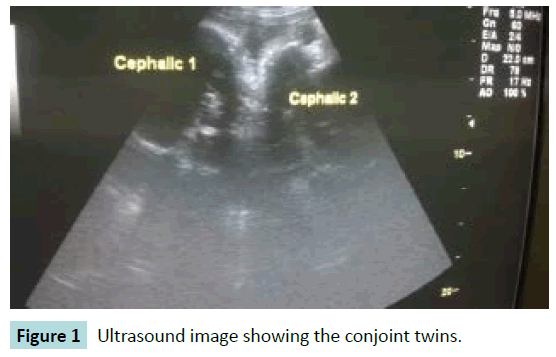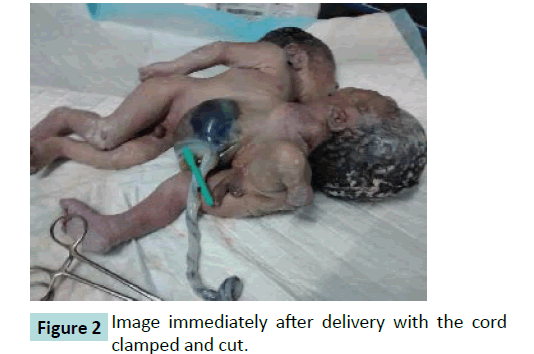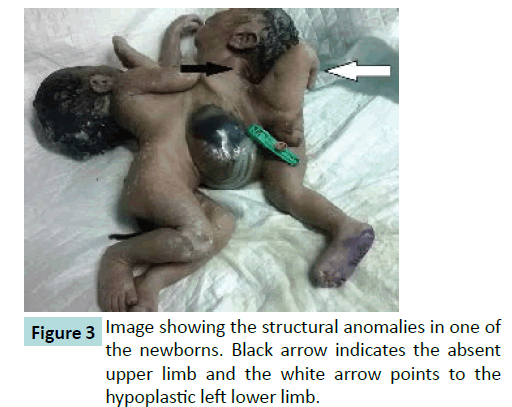Keywords
Conjoint twins; Foetus; Thoracopagus; Caesarean; Monochorionic twins; Gestation
Introduction
Conjoined twins are a rare phenomenon of a monochorionic monoamniotic twin. The incidence varies from 1 in 50000 to 1 in 100000 live births [1,2]. Female foetuses are more commonly affected with the ratio of male to female being 1:3, particularly in thoracopagus type [3]. Five types of conjoint twins are classically described, Thoracopagus, Omphalopagus, Pygopagus, Ischiopagus and Craniopagus. With a reported incidence of 74- 75% of all conjoint twins, Thoracopagus is the most common type. Omphalopagus with an incidence of 0.5% is the least common. Spencer et al divided the conjoined twins into following three major groups: twins with a ventral union, twins with a dorsal union and twins with a lateral union [2]. The first major group according to site of fusion includes: cephalopagus (head), thoracopagus (chest), Omphalopagus (umbilicus) and ischiopagus (hip). The dorsal union includes three types namely: pygopagus (sacrum), rachipagus (spine) and craniopagus (cranium). The last major group includes only one type of twins that is parapagus (side) twins [2]. Incidence of thoraco-omphalopagus is 28% [3]. If the diagnosis could be made before fetal viability, termination of pregnancy is offered to the patient. Conjoint twins can be diagnosed by pre natal ultrasound. However in underdeveloped countries which lack adequate maternal health care facilities, diagnosis could be delayed. Preterm delivery is most common outcome. Vaginal delivery is reserved for still births and conjoined twins who do not survive [4]. Around 40% of the conjoint twins are stillborns and around 35% die within 24 hours of delivery [4]. In thoracopagus, the perinatal outcome is determined by the degree of fusion of the heart [5]. In the order of the frequency, the pygopagus twins have better prognosis than the Omphalopagus and the thoracopagus twins.
We here are describing the case of a pregnant woman referred to our institute with a suspected diagnosis of conjoined twins at 34.5 weeks with the first ultrasound done at 34 weeks. This case report is unique in the sense that it not only reports a rare obstetric condition but also emphasizes on the fact that even after progresses made in the field of medicine, there still exists a gap in healthcare facility availability in developing countries.
Case Report
The woman was 19 years old, primigravida and had spontaneous conception. There was no family history of twins. The pregnancy was not booked and supervised at any medical center. First ultrasound (USG) examination was done at 34 weeks of gestation by a radiologist. It showed presence of a foetus with two heads but with one thoracic cavity and hence was referred to us. She presented to the labour room of our hospital in active labour. USG in labour room revealed presence twin foetuses with two heads at the same level with a single heart and multiple limbs thereby suggesting a diagnosis of conjoint twins and confirming the findings of the radiologist Figure 1 represents the ultrasonographic picture). On clinical examination she had moderate regular contractions. A per vaginum examination showed a cervix of 6 cm dilatation and 80% effacement; the presenting part was high up. There was no descent of the presenting part even after 2 hours. A decision for an emergency Lower segment caesarean section (LSCS) was taken and the patient prepped after explaining the situation and obtaining consent.
Figure 1 Ultrasound image showing the conjoint twins.
Lower segment caesarean section was performed by the senior surgeon and twins were delivered by breech extraction. The twins were alive at the time of delivery. The twins were males and were sharing the same thoracic cavity and omphalocele. Figure 2 shows the clinical picture after delivery). Contents of the omphalocele were liver and intestine which were apparent on visual examination of the sac. One of the twins had multiple congenital malformations - the left upper limbs were absent; the left lower limb was deformed (amniotic bands) and there was craniosynostosis (Figure 3). Combined weight of the twins was 2.9 kg. Apgar scores of the twins at 1min, 5 mins and 10 mins were 2, 3 and 5 respectively.
Figure 2 Image immediately after delivery with the cord
clamped and cut.
Figure 3 Image showing the structural anomalies in one of
the newborns. Black arrow indicates the absent
upper limb and the white arrow points to the
hypoplastic left lower limb.
The parents of the twins belonged to a poor economic background and were not willing for extended neonatal care of the twins. Even after being put on supportive care the medical condition of the twins started deteriorating over time and they expired 4 hours after bein delivered.
Discussion
Conjoint twins are believed to be the outcomes of a faulty division of an embryo at 13-15 days of conception. The underlying pathogenic mechanism is still uncertain and a number of theories have been postulated which include incomplete separation of the developing embryo, development of co-dominant axes and embryonic fusion [6] among others. Recently the “Fusion theory” has been accepted, because it can explain all the conjoined twin phenomena [7]. There is no association of conjoined twins with race, parity, maternal age or heredity. It is sporadic and recurrence risk is negligible. Ultra-sonography is the most accurate pre natal diagnostic technique for this condition. In the early weeks of pregnancy, the foetal movements are limited and the monochorionic twins may be mistaken for conjoined twins. Hence, a repeat ultrasonographic examination should ideally be done at between the eleventh and twelth weeks of gestation, to confirm the diagnosis and to avoid discovering a conjoint twin later [8]. The low incidence and poor outcomes of this condition necessitates adequate vigilance on part of the radiologist and the obstetrician so as to avoid problems during the later parts of the pregnancy. Surgical separation of nearly complete conjoined twins may be successful when organs essential for life are not shared. Prognosis of conjoined twins is poor. In a study of 14 cases of prenatally diagnosed conjoined twins, 28% of cases died in utero and 54% died immediately after birth. 18% of conjoined twins survived, out of which 50% died postoperatively [3,9,10]. The prognosis of cephalo thoracopagus is extremely poor because a single brain and heart are present with fused gastrointestinal tracts [9,10]. Thoraco omphalopagus is a rare type of conjoint twins. A pubmed search done on July 21, 2015 with the key words “conjoint twins” and “Thoraco omphalopagus” returned 53 hits describing 63 cases of thoraco omphalopagus, which is an indication of the rarity of this condition. Table 1 summarises the details of 49 of the 63 cases reported till date. Details of 14 cases were not available and/or accessible and hence have not been reported in the table. The outcomes of surgical separation appear to be good in selected cases. In the case reported by us surgical separation was not possible as the twins shared a single heart, liver and spleen. Moreover, surgical separation needs the presence of surgeons with adequate experience in handling such cases. Also, surgical management would necessitate prolonged neonatal ICU requirement which may not be possible for many of the patients having a poor economic background. The case reported by us adds to the available pool of knowledge on this condition. Moreover, this highlights the inadequacy of health facilities in developing countries, where a basic pre natal ultrasound was not done in the early gestation and hence emphasizes the need to beef up the health facilities in these countries.
| Time of diagnosis |
Number of case reported |
Termination of pregnancy |
Pregnancy continued after diagnosis |
Post termination status |
| First trimester |
5 |
4 |
1 |
Died postcaesarean delivery-1 |
| Second trimester |
21 |
12 |
9 |
Surgically separated post caesarean delivery & living-9 |
| Third trimester |
23 |
23 |
- |
Surgically separated & living-12,
Surgically separated & died-3,
Surgically non separable-8 |
Table 1: Details of cases of conjoint twins reported in literature.
References
- Mutchinick OM, Luna-Muñoz L, Amar E, Bakker MK, Clementi M, et al. (2011) Conjoined twins: a worldwide collaborative epidemiological study of the International Clearinghouse for Birth Defects Surveillance and Research. Am J Med Genet C Semin Med Genet157 C(4):274-87.
- Spencer R (1996) Anatomic description of conjoined twins: a plea for standardized terminology. J Pediatr Surg 31: 941-944.
- Graham GM, Gaddipati S (2005) Diagnosis and management of obstetrical complications unique to multiple gestations. Semin Perinatol 29: 282-295.
- Sakala EP (1986) Obstetric management of conjoined twins. Obstet Gynecol 67: 21S-25S.
- Razavi-Encha F, Mulliez N, Benhaiem-Sigaux N, Gonzales M, Casasoprana A, et al. (1987)Cardiovascular abnormalities in thoracopagus twins: embryological interpretation and review. Early Hum Dev 15(1):33-44.
- https://www.rcog.org.uk/globalassets/documents/guidelines/t51managementmonochorionictwinpregnancy2008a.pdf
- Spencer R (2000) Theoretical and analytical embryology of conjoined twins: part I: embryogenesis. Clin Anat 13: 36-53.
- Pajkrt E, Jauniaux E (2005) First-trimester diagnosis of conjoined twins. Prenat Diagn 25: 820-826.
- Stone JL, Goodrich JT (2006) The craniopagus malformation: classification and implications for surgical separation. Brain 129: 1084-1095.
- Hill LM (1997) The sonographic detection of early first-trimester conjoined twins. Prenat Diagn 17: 961-963.




